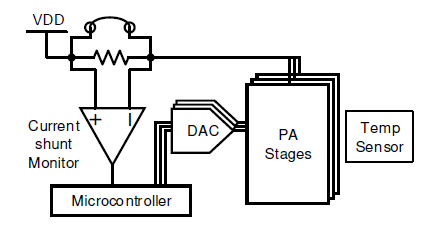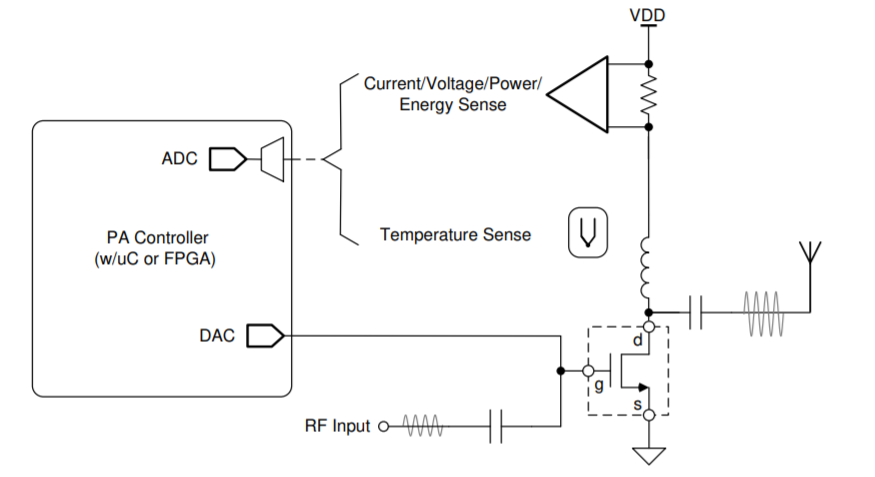SSZT359 december 2019 INA202 , INA226 , INA2290 , INA240 , INA281 , INA290 , TMCS1100 , TMCS1101
Power amplifiers (PAs) play a critical role in the system architecture of wireless infrastructure. As the number of channels within active antenna systems (AASs) and remote radio units (RRUs) increase from four up to 128 and beyond with the expansion of 5G, the number of PAs is increasing at the same rate to support the multiple-input-multiple-output architecture of the AAS and RRU.
An increased channel count affects PA performance, since the system consumes more energy, thus increasing the temperature. Keeping the PA under control, meaning that current and temperature are kept within a specified safe operating range is directly related to device performance and longevity. To achieve system safety and efficiency, system designers are using various sensors to monitor activity in the PA.
In this article, I’ll review advancements in wireless infrastructure applications for high-voltage gallium nitride (GaN) or laterally diffused metal-oxide semiconductor (LDMOS) PAs in AAS and RRU systems for monitoring system vitals – in this case, current-sense amplifiers (CSAs).
Current sensors in PA current monitoring
There are several uses for current sensors to ensure the correct functionality and longevity of a PA, including calibrating, field maintenance and real-time monitoring. Monitoring the current going into a PA or a node enables the adjustment of its gate bias voltage in order to ensure that it is performing in the optimal range. CSAs such as TI’s INA290 and INA2290 offer very low offset and gain error along with high-voltage capability across the common mode, which is a good fit for high-side sensing where a high level of accuracy is required. With the INA290 and INA2290, you can directly take accurate measurements of a PA on a >48-VDC power supply.
During calibration of a PA in a factory (as illustrated in Figure 1), a look-up table is created by monitoring current by using one CSA per PA or one CSA per two PAs. The amount of CSAs depends on board space and the level of accuracy required. Using a single CSA per PA will provide the most accurate data, since the current data isn’t being averaged across several PAs. Correct calibration of the PA in the factory is essential to longevity of the device and performance in the field.
 Figure 1 Factory calibration
Figure 1 Factory calibrationMaintaining and adjusting the AAS and RRU PAs after systems deployment is another implenmention for a CSA because the system may need adjustments over time as components wear and break down. When systems are deployed into environments with large temperature deltas, the CSA can help adjust the gate voltage of the PA to ensure optimal performance throughout changing weather conditions. With this adjustment technique, the system needs to be powered off and then recalibrated remotely by monitoring current entering the PA during a remote calibration cycle. Adjusting the voltage gates of the PA accordingly ensures proper operation and the highest efficiency.
Continually monitoring a device in real time is another way to analyze PA performance. In this case, the CSA is providing data to a digital-to-analog converter (DAC), which is controlling the LDMOS or GaN device by adjusting the gate voltages in real time. Enabling the adjustment of the gate voltage in real time will result in optimal performance and power consumption in all operating conditions and load levels. This technique does not require taking the system offline to adjust the gate voltages, since there is a real-time communication channel directly to the processor that makes any necessary adjustments. Adjusting the gate voltages in real-time is a design challenge, however, because you’ll need to create complex algorithms or an application-specific integrated circuit to handle the data from the DAC.
System protection and consumption
It is important to protect the PA from overcurrent situations, since it is one of the most expensive components in the system. Placing a CSA on the high-side of a PA equipped with a fast-action internal comparator such as the INA202 that offers a typical response time of 1.3 µS and a common-mode voltage range up to 80 V. This solution provides overcurrent detection to ensure that the PA is not damaged due to a high current event. A digital power monitor such as the INA226 can monitor power being delivered to the PA to ensure that the PA stays within technical operating specifications throughout its lifetime and operates correctly in various environments. The INA226 monitors current, voltage and power and provides user alerts, which are then sent through the I2C interface for reliable communication with a processor.
 Figure 2 System protection configuration
Figure 2 System protection configurationPower delivery and power supplies
A high-voltage AC power sourced from the electrical grid provides power to a wireless infrastructure base station. It is important to monitor the high-voltage AC coming from the power grid to ensure that the system does not experience a condition such as a power surge or outage, which may damage components in the power supply and prohibit the system from operating correctly.
To monitor high AC voltages <600 Vpk, TI’s TMCS1100 and TMCS1101 devices have a maximum total error of <1% or <1.5%, respectively, and isolation from high voltages. In addition, the TMCS1100 and TMCS1101 are very stable over a temperature range, making them a good fit for outdoor systems. Adding this device to a system is an additional layer of protection for the system, making sure that it is correctly sourcing AC power.
For DC/DC converters, the INA240 provides enhanced pulse-width modulation rejection and bidirectional operation. This means that the device will avoid glitches in the current measurements from sharp common-mode transitions, which leads to accurate measurements. Depending on the converter’s power levels, thermal generation or heat can manifest quickly. The INA240 has a low thermal drift specification, which means that the current measurement does not change significantly with heat generation, ultimately providing accurate measurements throughout the entire operating range.
Conclusion
Current sensing provides many benefits to a system, including optimized performance, efficiency, improved reliability and condition monitoring to protect system vitals. Since CSAs enable direct measurements with highly accurate results, they can help extend the reliability and life of PAs while supporting a variety of functions and features in a system.
Additional resources:
- Read the Application Note, “Improving Power Amplifier Efficiency with Current Monitors.”
- Read the TechNote, “Current Sensing Applications in Wireless Infrastructure Equipment.”
- Review the Reference Design, “–48-V Telecom Current, Voltage, and Power Sense With Isolation Reference Design.”